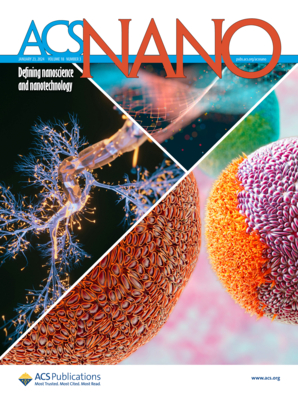Co3Sn2S2纳米片磁畴反常光能效应的显微成像。
IF 15.8
1区 材料科学
Q1 CHEMISTRY, MULTIDISCIPLINARY
引用次数: 0
摘要
磁畴成像技术对于基础物理和各种应用领域,如磁存储和自旋电子学,都是至关重要的。利用光对磁畴的观察,通常是基于磁光学显微镜,是微米分辨率的磁畴可视化最有效的技术之一。在这项工作中,我们展示了一种基于反常光能效应的替代方法,适用于磁性Weyl半金属。通过扫描光电流显微镜,我们观察到在不同磁化方向下载流子的局部热扩散通过反常能司特效应在磁畴壁处产生了明显的光电流,从而实现了磁畴的显微成像。基于磁光克尔效应和磁圆二色性的方法依赖于左右圆偏振光的不同响应,通常需要额外的快速偏振调制,相比之下,该方法提供了一种方便可靠的方法,无需任何故意的光偏振控制。本文章由计算机程序翻译,如有差异,请以英文原文为准。
Microscopic Imaging of Magnetic Domains through Anomalous Photo-Nernst Effect in Co3Sn2S2 Nanoplates.
Magnetic domain imaging technologies are critical to both fundamental physics and various application fields, such as magnetic storage and spintronics. The observation of magnetic domains using light, typically based on magneto-optical microscopy, is one of the most effective techniques for visualizing magnetic domains with micrometer resolution. In this work, we demonstrate an alternative approach based on the anomalous photo-Nernst effect that is applicable to magnetic Weyl semimetals. Through scanning photocurrent microscopy, we observe a pronounced photocurrent at the domain wall, arising from the local thermal diffusion of carriers under different magnetization directions via the anomalous Nernst effect, enabling the microscopic imaging of magnetic domains. Comparing with methods based on the magneto-optical Kerr effect and magnetic circular dichroism, which rely on the different response to the left and right circularly polarized light and typically require additional fast polarization modulation, the reported approach offers a convenient and reliable method without any intentional light polarization control.
求助全文
通过发布文献求助,成功后即可免费获取论文全文。
去求助
来源期刊

ACS Nano
工程技术-材料科学:综合
CiteScore
26.00
自引率
4.10%
发文量
1627
审稿时长
1.7 months
期刊介绍:
ACS Nano, published monthly, serves as an international forum for comprehensive articles on nanoscience and nanotechnology research at the intersections of chemistry, biology, materials science, physics, and engineering. The journal fosters communication among scientists in these communities, facilitating collaboration, new research opportunities, and advancements through discoveries. ACS Nano covers synthesis, assembly, characterization, theory, and simulation of nanostructures, nanobiotechnology, nanofabrication, methods and tools for nanoscience and nanotechnology, and self- and directed-assembly. Alongside original research articles, it offers thorough reviews, perspectives on cutting-edge research, and discussions envisioning the future of nanoscience and nanotechnology.
 求助内容:
求助内容: 应助结果提醒方式:
应助结果提醒方式:


